Skiers have reservations over airbag safety system

Some skiers are concerned they will turn into the puffy "Michelin Man" when they are not supposed to.
Others are afraid they will lose precious hundredths of a second due to slightly more wind resistance.
And still more believe that their movements will be restricted.
Whatever the reasons, few—if any—skiers are expected to use a radical new airbag safety system in January when it will be cleared for use in World Cup downhill races.
"January could still be early. But not because we have problems but because the athletes are not confident," said Marco Pastore, the sponsoring manager for Italian manufacturer Dainese, which developed the system with the International Ski Federation through four years of data collection and testing.
The airbag fits in a vest that is incorporated into skiers' back protectors and is designed to inflate when skiers lose control and are about to crash. A 4.5-centimeter long (1.8-inch) gas generator inflates the airbag and the entire system adds about 800 grams (less than two pounds) of weight to the back protector.
"I'm encouraging my guys to try it, to get fit for it," U.S. men's head coach Sasha Rearick said. "The plastic where the airbag is itself is quite stiff. The way it fits is what they're working on right now, to make sure they can move comfortably with it."
Dainese-sponsored athletes like Werner Heel of Italy and Jan Hudec and Manuel Osborne-Paradis of Canada have been testing the system in training for two seasons. Bode Miller is in the first year of a sponsorship deal with Dainese but he's been out following back surgery.
"We need to fit the suits better to incorporate it," Heel said, adding that he's not ready to race with it yet.

Dainese introduced a similar system for motorcycle racing a decade ago.
"It took 10 years to get all (the riders) to wear the system," Pastore said. "At the beginning we were asking them to use it. Now they ask us."
Pastore discussed the project Saturday, a day after Florian Scheiber of Austria crashed and was airlifted off the downhill course by helicopter with a concussion and bruises all over the left side of his body.
"For the Florian Scheiber crash, it would have been very good," Pastore said, noting that the airbag can protect the neck, shoulders, trunk and back areas.
"They'll use it, you'll see," said FIS men's World Cup director Markus Waldner. "If you go flying off an icy course at 140 kph (90 mph) and all of a sudden you have protection around your neck and upper body, that's pretty good. That's why the MotoGP riders use it."
But skiers need to move their bodies more than motorcycle riders.
"It's a little bit slower because it's not aerodynamic like wearing nothing under the suit," said Olympic downhill champion Matthias Mayer.
"That's not true," Waldner said. "The Austrian and Italian teams tested it in the wind tunnel in Maranello and all of the data showed it's not a disadvantage."
The system is not available for sale yet but a potential price tag could run about 1,000 euros ($1,230), Pastore said, adding that any World Cup athlete can have free access to it.
While the system has been cleared for optional use on both the men's and women's circuits, the only female skier to test it so far is a Swiss Europa Cup skier.
"Anything that's going to improve our safety is something that should be considered but at the same time I have my worries about it," American skier Lindsey Vonn said. "What if you went off a jump and you landed totally fine and for some reason the impact made it deploy? But if it's proven to be more safe then it's definitely something I would try in training."
Vonn has been slowed over the past two seasons by a series of knee tears, the most common injury to skiers.
An airbag for the knees and legs is the next project Dainese is hoping to develop.
"We have some ideas about the knees," Pastore said. "There is some data on the table."
© 2014 The Associated Press. All rights reserved.
















